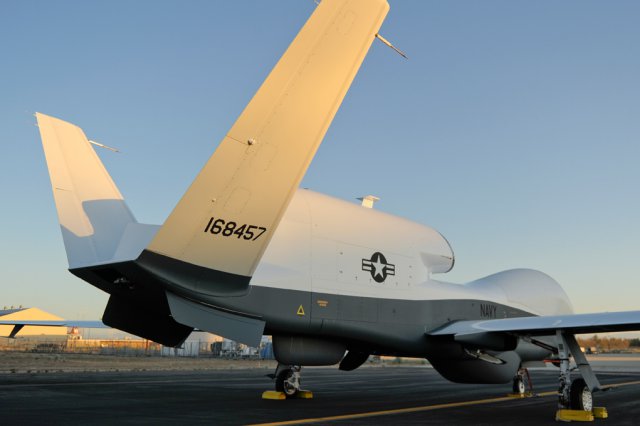 The U.S. Navy’s MQ-4C Triton unmanned maritime surveillance aircraft is progressing through its flight-test programme, but still without a “sense-and-avoid” system that would protect against collisions with other aircraft. The Naval Air Systems Command (Navair) programme office said it is taking a “layered approach” to meeting the requirement until it finds a technology solution.
The U.S. Navy’s MQ-4C Triton unmanned maritime surveillance aircraft is progressing through its flight-test programme, but still without a “sense-and-avoid” system that would protect against collisions with other aircraft. The Naval Air Systems Command (Navair) programme office said it is taking a “layered approach” to meeting the requirement until it finds a technology solution.
At a programme briefing at the Navy League Sea-Air-Space conference on April 8, Navair still listed Exelis as providing the radar subsystem that will help the Triton comply with an International Civil Aviation Organization (ICAO) requirement that military aircraft fly with “due regard” for the safety of other aircraft when operating over international waters. The Navy revealed last summer that it had directed Triton manufacturer Northrop Grumman to stop work on the due-regard radar while it considered other options. Exelis remains on contract, Mike Mackey, Northrop Grumman’s Triton programme manager, told reporters.
Exelis built a small active electronically scanned array (AESA) radar for the MQ-4C that it exhibited during its development in 2012. “The sense-and-avoid technical solution turned out to be very challenging for us, and one of the keys to that challenge was trying to squeeze an AESA radar into the size [available], with the weight and power and cooling allocations that we were able to provide for that system,” said Sean Burke, Deputy Programme Manager of Navair’s PMA-262 persistent maritime unmanned aircraft systems program office. “Miniaturizing that kind of a radar suite has turned out to be more challenging than we initially thought. So we’re stepping back from it, we’re taking a very hard look at what the right way forward is.”
The Triton programme is taking a “layered approach” to meeting the due regard requirement, he said, using available systems that include the transponder-based traffic alert collision avoidance system (Tcas) and GPS-based automatic dependent surveillance-broadcast (ADS-B) position reporting. Civil aviation authorities do not consider either system, by itself, to be adequate for unmanned aircraft sense-and-avoid capability.
The Navy is working with the U.S. Federal Aviation Administration and international authorities “to lay in the airspace integration plan. We actually believe that we’re leading the pack for that sort of airspace integration work,” Burke said. “TheFAA has been extremely supportive of us as we work through our flight-test programme, so we’re fairly confident that we’re going to be able to provide a solution that works, whatever airspace we’re [operating in]. But it takes time to get there; it takes agreements that need to get made.”
The Triton, based on Northrop Grumman’s RQ-4B Global Hawk, first flew in May 2013 and has completed 13 flights as part of its envelope expansion phase, Mackey said. The programme completed 36 test flights on a surrogate Gulfstream II to prove its main sensor, Northrop Grumman’s multi-function active sensor (MFAS), a 360-degree AESA maritime surveillance radar. The Navy expects a Milestone C decision authorizing Triton production in mid-2016, a schedule that has lapsed by more than a year; “early operational capability” of two delivered air vehicles in 2017; and formal initial operational capability of four aircraft in 2018.
Source: AIN Online
